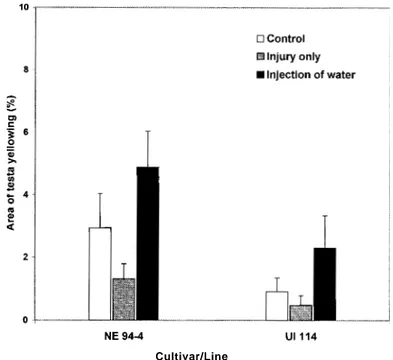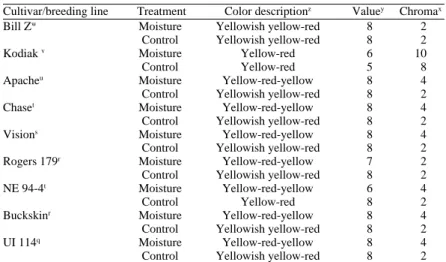Testing the Effects of Moisture on Seedcoat Color of Pinto Dry Beans
Tam metin
(2) complete block with 12 replications. Bean genotypes ‘UI 114’ and NE 94-4 were used as blocks. A total of 72 plants were grown. On 27 Mar. 1998, 15 d before physiological maturity, the treatments were applied to the pods. Three pods were selected from the base, middle, and upper parts of each plant for each of three treatments. For the injury-only treatment, a hypodermic syringe was inserted into each pod near the pedicel. For the injection with water treatment, a hypodermic syringe was used to inject 5 mL of deionized water into the pod through the pod suture near the pedicel. After 15 d, the percentage of yellowing of seeds from each of the three pods per plant was recorded. Moistened filter paper experiments. This experiment was conducted in the laboratory during Apr. 1998. The design was a randomized complete block with four replications. Pinto ‘UI 114’ and NE 94-4 were arranged in blocks. The two treatments consisted of dry seeds placed on either moistened or dry (control) filter paper in petri dishes. Pods were randomly selected from control plants in the injection experiment described previously. Each pod was opened in the dark. The seed was extracted and placed immediately in a petri dish. Twenty seeds were placed on either moist or dry filter paper in each dish. The petri dishes were then sealed with tape to prevent air exchange, and kept in the dark during the experiment at 21 °C. The percentage of seedcoat yellowing was recorded 7 d after the initiation of the experiment. A second moistened filter paper experiment was performed to evaluate diverse pinto bean germplasm for seedcoat yellowing. Eight pinto cultivars and breeding line NE 94-4 were evaluated for the response to seedcoat yellowing in the presence of moisture, using the same procedure developed in the moistened filter paper experiment described above. The experimental design was a randomized complete block with two replications. Twenty seeds of each bean genotype were placed on moistened filter paper per petri dish per replicate, and on dry filter paper for the control treatment. Color of seeds was recorded 7 d after initiation of the experiment. Measurement of seedcoat yellowing and statistical analysis. Yellowing was recorded visually by determining the percentage of the yellow area on a bean seed in the experiments. A scale from 0% to 100%, measured in 10% intervals, was used. The mixed model procedure (Littel et al., 1996) was used to obtain appropriate statistical estimates and to test data in all three experiments. Color, value (lightness), and chroma (strength) of the seeds of each of the pinto entries in the moistened filter paper germplasm experiment were recorded as described in the Munsell™ Book of Color (1929–42 pocket edition; Munsell Color Co., Baltimore). The color, value, and chroma are read together to give a description of the color and how it changes. In general, for value, the higher the number, the lighter the shade of color. For chroma, the lower the number, the stronger or deeper the shade.. The data showed no variation within each variety. Thus, the means of the control and moisture treatment as separated by genotypes were the only values examined and presented. No statistical analysis was necessary. Results and Discussion Misting experiment. Both the cultivar/ breeding line effect, (Type III F value = 6.70, P ≤ 0.0125) and the interaction between cultivar/breeding line and pod were significant (Type III F value = 2.63, P ≤ 0.0512) such that NE 94-4 seeds showed a higher. percentage of seedcoat yellowing (8.4%) than did ‘UI-114’ seeds (2.6%). If misting affected yellowing, this would be expected because NE 94-4 is susceptible and ‘UI-114’ is resistant to seedcoat yellowing. This response to misting is analogous to seeds in bean pods lying on moist ground after cutting the plants in the field during a wet fall. Thus, the moisture could cause the seeds to become discolored. In 1997, seedcoat yellowing of NE 94-4 was noted in cut bean plants lying on wet ground, while seeds from adjacent uncut plants of the same line showed little yellowing.. Cultivar/Line. Fig. 1. Effect of injection of water on the percentage of seedcoat yellowing of two bean genotypes under the three different treatments. Means differed significantly within cultivar/lines at P ≤ 0.0238 and represent 12 replications per treatment. Vertical bars = SE.. Cultivar/Line. Fig. 2. Percentage of seedcoat yellowing of the two bean entries under two different treatments (control, moistened) in the moistened filter paper experiment. Means differed significantly within cultivars/ lines at P ≤ 0.001 and represent four replications per treatment. Vertical bars = SE..
(3) Injection experiment. When pods were injected with water, NE 94-4 again showed more seedcoat yellowing than did ‘UI 114’ (Fig. 1; Type III F value = 4.01, P ≤ 0.0238). The water injection treatment was associated with more seedcoat yellowing than occurred in control seeds. The mechanism causing the change in seed color pigmentation in the presence of moisture is unknown. Moistened filter paper experiments. Seeds placed directly on the moist filter papers showed some yellowing after 1 d. Yellowing became more extensive after 3 d with NE 94-4 developing more seedcoat yellowing than ‘UI 114’ (Type III F value = 2518.010, P ≤ 0.0001). The seeds of NE 94-4 on moistened filter paper yellowed more (80%; Fig. 2) than those taken from the pods injected with water (5%; Fig. 1), or from those pods which were exposed to mist in the greenhouse (8.5%; data not shown). The difference in yellowing. may be due to the more uniform contact between the seed and moisture in the petri dishes, while in the other two cases the seeds matured in the presence of moisture, and dried down. In the misting experiment and the field, seeds were shielded from moisture by the pods. Seedcoat discoloration may result from other factors, such as storage. Certain pinto genotypes such as ‘Chase’ tend to develop a brownish color when stored dry for a long time. Light exposure and temperature may also interact with moisture and genotypes to cause seedcoat discoloration (Hughes and Sandsted, 1975). However, these two factors were held constant in our studies. A combination of base color, value (lightness), and chroma (strength) in combination was used to describe the color of each bean genotype. Seeds of NE 94-4 and ‘Kodiak’ showed the most pronounced color changes in the moistened filter paper test (Table 1). NE. Table 1. Differentiation of seedcoat color traits of pinto bean genotypes in response to moisture using the moistened filter paper test. A statistical analysis of data was not carried out because no variation was observed. Treatment Color descriptionz Valuey Chromax Moisture Yellowish yellow-red 8 2 Control Yellowish yellow-red 8 2 v Kodiak Moisture Yellow-red 6 10 Control Yellow-red 5 8 Apacheu Moisture Yellow-red-yellow 8 4 Control Yellowish yellow-red 8 2 t Chase Moisture Yellow-red-yellow 8 4 Control Yellowish yellow-red 8 2 Visions Moisture Yellow-red-yellow 8 4 Control Yellowish yellow-red 8 2 r Rogers 179 Moisture Yellow-red-yellow 7 2 Control Yellowish yellow-red 8 2 NE 94-4t Moisture Yellow-red-yellow 6 4 Control Yellow-red 8 2 Buckskinr Moisture Yellow-red-yellow 8 4 Control Yellowish yellow-red 8 2 UI 114q Moisture Yellow-red-yellow 8 4 Control Yellowish yellow-red 8 2 z Munsell™ Book of Color, 1929–42, pocket edition (Munsell Color Co., Baltimore). y The color, value, and chroma are read together to give a description of the color and how it changes. For value, the higher the number, the lighter the shade of color. x For chroma, the lower the number the stronger or deeper the shade. w Colorado State Univ., Fort Collins. v Michigan State Univ., East Lansing. u Idaho Seed Bean, Twin Falls, Idaho. t Univ. of Nebraska, Lincoln. s Seminis–Asgrow, Twin Falls, Idaho. r Novartis–Rogers Bros., Nampa, Idaho. q Univ. of Idaho, Kimberly. Cultivar/breeding line Bill Zw. 94-4 changed from a pale beige and became more yellow with a touch brown as shown by a decrease in lightness (value) and an increase in strength of the color (chroma), while ‘Kodiak’ became more red with a significant increase in the strength of the color. The cultivar Bill Z showed the least change in seedcoat color in response to moisture, a trait highly desired by bean growers, processors, and consumers. The lightness (value) of seeds of ‘Apache’, ‘Chase’, ‘Vision’, ‘Buckskin’, and ‘UI-114’ did not change in the presence of moisture, but all of these genotypes showed an increased in strength of the color (a shift from pale beige to tan). These results again confirmed that the presence of moisture on mature pinto seeds caused seedcoat yellowing on susceptible lines. We recommend that the moistened filter paper test be used by researchers to detect lines that are susceptible to seedcoat yellowing in response to moisture. Literature Cited Deshpande, S., S.K. Satyhe, and D.K. Salunkhe. 1984. Interrelationships between certain physical and chemical properties of dry bean. Qual. Plant Foods Hum. Nutr. 34:53–65. Hughes, P.A. and R.F. Sandsted. 1975. Effect of temperature, relative humidity, and light on the color of ‘California Light Red Kidney’ bean during storage. HortScience 10:421–423. Littell, R.C., G.A. Milliken, W.W. Stroup, and R.D. Wolfinger. 1996. SAS system for mixed models. SAS Inst., Cary, N.C. Munsell Color Co., Inc. 1929–42. Munsell™ book of color, pocket ed. Munsell Color Co., Baltimore. Prakken, R. 1972. Inheritance of colors in Phaseolus vulgaris. III. On genes for red seed coat colors and a general synthesis. Medelingen Landbouwhogeschool, Wageningen, The Netherlands. Prakken, R. 1974. Inheritance of colors in Phaseolus vulgaris L. IV. Recombination within the ‘complex locus C’. Medelingen Landbouwhogeschool, Wageningen, The Netherlands. Schwartz, H.F., M.A. Brick, D.S. Nuland, and D.B. Franc. 1996. Dry bean production and pest management. Reg. Bul. 562A. Coop. Ext. Res. Ctr., Colo. State Univ., Fort Collins. Singh, S.P. 1999. Production and utilization, p. 1– 24. In: S.P. Singh (ed.). Common bean improvement in the twenty-first century. Developments in plant breeding Vol. 7. Kluwer Acad., Dordrecht, The Netherlands. Smith, F.L. 1961. Seed-coat color genes in six commercial varieties of beans. Hilgardia 31:1–14..
(4)
Şekil


Benzer Belgeler
Ancak bilindiği üzere Đşçi Sağlığı ve Đş Güvenliği Tüzüğünde belirtilen ve kontrolleri zorunlu olan makina ve cihazların; tasarımı, üretimi, işletilmesi ve
Dünyada Amerikan Boeing ve Avrupa ülkelerinin ortaklığı olan Airbus ın iki büyük tekel konumunda olduğu Havacılık sanayiinin, ülkemizde kurulması ve
Önceki gece Esto.nya’nm başkenti Tallinn ile İsveç’in başkenti Stockholm arasın da sefer yapan Estonia adlı feribot, bilinmeyen nedenler den alabora oldu...
dığı gazel bir Divana muadildir; Pa şa olan şairler içinde, keza her mıs raı, bir vecize, bir daılbımesel kudre tinde olan meşhur Ziya Paşa, isminin
Mart 1917'de 'National Society for the Promotion of Occupational Therapy' ilk toplantýsýný yapmýþ ve 1921'de 'American Occupational Therapy Associa- tion' adýný almýþtýr ve
Araknoid kisti spontan ya da travma sonrasında subdural alana rüptüre olan olgularda; Klinik ve radyolojik olarak kanama, kitle etkisi gibi bulgular yoksa, araknoid kist sıvısının
time-scales, τ and σ, the particle can exhibit a directed motion in response to the temperature gradient; further- more, studying the long-term stationary particle distri- bution,
Since female sex hormones play an important role in common primary headache disorders such as migraine and others, we aimed to evaluate the frequency and types of